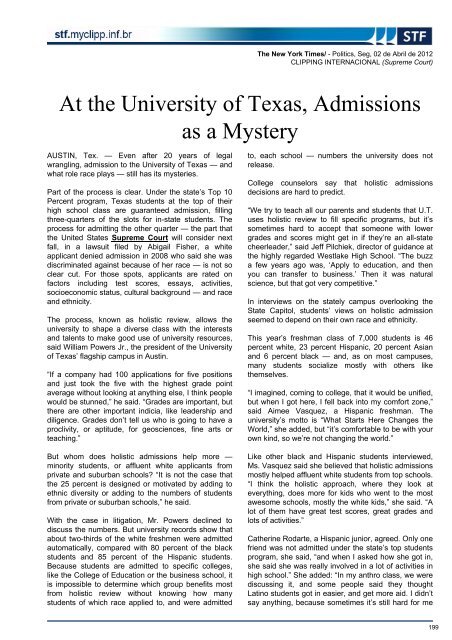STF na MÃdia - MyClipp
STF na MÃdia - MyClipp
STF na MÃdia - MyClipp
Create successful ePaper yourself
Turn your PDF publications into a flip-book with our unique Google optimized e-Paper software.
The New York Times/ - Politics, Seg, 02 de Abril de 2012<br />
CLIPPING INTERNACIONAL (Supreme Court)<br />
At the University of Texas, Admissions<br />
as a Mystery<br />
AUSTIN, Tex. — Even after 20 years of legal<br />
wrangling, admission to the University of Texas — and<br />
what role race plays — still has its mysteries.<br />
Part of the process is clear. Under the state’s Top 10<br />
Percent program, Texas students at the top of their<br />
high school class are guaranteed admission, filling<br />
three-quarters of the slots for in-state students. The<br />
process for admitting the other quarter — the part that<br />
the United States Supreme Court will consider next<br />
fall, in a lawsuit filed by Abigail Fisher, a white<br />
applicant denied admission in 2008 who said she was<br />
discrimi<strong>na</strong>ted against because of her race — is not so<br />
clear cut. For those spots, applicants are rated on<br />
factors including test scores, essays, activities,<br />
socioeconomic status, cultural background — and race<br />
and ethnicity.<br />
The process, known as holistic review, allows the<br />
university to shape a diverse class with the interests<br />
and talents to make good use of university resources,<br />
said William Powers Jr., the president of the University<br />
of Texas’ flagship campus in Austin.<br />
“If a company had 100 applications for five positions<br />
and just took the five with the highest grade point<br />
average without looking at anything else, I think people<br />
would be stunned,” he said. “Grades are important, but<br />
there are other important indicia, like leadership and<br />
diligence. Grades don’t tell us who is going to have a<br />
proclivity, or aptitude, for geosciences, fine arts or<br />
teaching.”<br />
But whom does holistic admissions help more —<br />
minority students, or affluent white applicants from<br />
private and suburban schools? “It is not the case that<br />
the 25 percent is designed or motivated by adding to<br />
ethnic diversity or adding to the numbers of students<br />
from private or suburban schools,” he said.<br />
With the case in litigation, Mr. Powers declined to<br />
discuss the numbers. But university records show that<br />
about two-thirds of the white freshmen were admitted<br />
automatically, compared with 80 percent of the black<br />
students and 85 percent of the Hispanic students.<br />
Because students are admitted to specific colleges,<br />
like the College of Education or the business school, it<br />
is impossible to determine which group benefits most<br />
from holistic review without knowing how many<br />
students of which race applied to, and were admitted<br />
to, each school — numbers the university does not<br />
release.<br />
College counselors say that holistic admissions<br />
decisions are hard to predict.<br />
“We try to teach all our parents and students that U.T.<br />
uses holistic review to fill specific programs, but it’s<br />
sometimes hard to accept that someone with lower<br />
grades and scores might get in if they’re an all-state<br />
cheerleader,” said Jeff Pilchiek, director of guidance at<br />
the highly regarded Westlake High School. “The buzz<br />
a few years ago was, ‘Apply to education, and then<br />
you can transfer to business.’ Then it was <strong>na</strong>tural<br />
science, but that got very competitive.”<br />
In interviews on the stately campus overlooking the<br />
State Capitol, students’ views on holistic admission<br />
seemed to depend on their own race and ethnicity.<br />
This year’s freshman class of 7,000 students is 46<br />
percent white, 23 percent Hispanic, 20 percent Asian<br />
and 6 percent black — and, as on most campuses,<br />
many students socialize mostly with others like<br />
themselves.<br />
“I imagined, coming to college, that it would be unified,<br />
but when I got here, I fell back into my comfort zone,”<br />
said Aimee Vasquez, a Hispanic freshman. The<br />
university’s motto is “What Starts Here Changes the<br />
World,” she added, but “it’s comfortable to be with your<br />
own kind, so we’re not changing the world.”<br />
Like other black and Hispanic students interviewed,<br />
Ms. Vasquez said she believed that holistic admissions<br />
mostly helped affluent white students from top schools.<br />
“I think the holistic approach, where they look at<br />
everything, does more for kids who went to the most<br />
awesome schools, mostly the white kids,” she said. “A<br />
lot of them have great test scores, great grades and<br />
lots of activities.”<br />
Catherine Rodarte, a Hispanic junior, agreed. Only one<br />
friend was not admitted under the state’s top students<br />
program, she said, “and when I asked how she got in,<br />
she said she was really involved in a lot of activities in<br />
high school.” She added: “In my anthro class, we were<br />
discussing it, and some people said they thought<br />
Latino students got in easier, and get more aid. I didn’t<br />
say anything, because sometimes it’s still hard for me<br />
199











